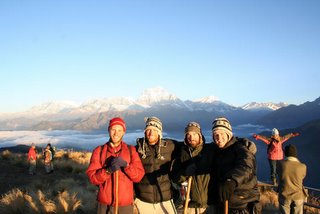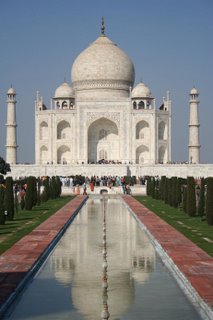

It was indeed a sad day to be leaving our beloved Nepal where the three of us had had such a fantastic time but although our tour of Rajasthan, a north-western province of India, was not to entail quite so many adventurous activities, I for one was pretty excited. Rajasthan was such a melting pot of Mughal, Hindu and British influences and cultures and I was very much looking forward to seeing the lands of the Maharajas that I'd read about in school. Sure we'd heard horror stories about touts, litter, beggars, smog, ridiculous traffic, mosquitos etc (and that was just describing Delhi airport), but I was keen for some real culture and history.

Red Fort in Delhi

The beautiful Golden Temple in Amritsar.
The trains I would think are one of the biggest legacies of the British Raj, you can pretty much travel from anywhere to anywhere in India via their incredibly extensive rail network and all in reasonable time, great comfort and at affordable expense. That is of course if you manage to book one of the air-conditioned classes before the tourist quota is exhausted; if you are forced to travel coach/cattle class, well that's a completely different story.

The slightly kitsch machismo of the border closing ceremony in Atari.
The good times continued as we checked out the magnificent Golden Temple in Amritsar, the most holy site of the Sikh religion and then it was over to the football atmosphere of the ridiculously camp and over-the-top Indian-Pakistani border closing ceremony, surely the inspiration for many a Monty Python sketch (or vice versa), 30 km west in the town of Atari. Yes, India was fun, fascinating and remarkably comfortable up to that point.
 In a tight one, I think the Pakistanis in all black were slightly more intimidating despite the imposing red peacock frill, long white gators and frilly cumerbun worn by the Indians.
In a tight one, I think the Pakistanis in all black were slightly more intimidating despite the imposing red peacock frill, long white gators and frilly cumerbun worn by the Indians.
From here on in, things started to go a little pear shaped. We had no set-in-stone itinerary at this stage and all we knew at this point that we wanted to head far south-west to the fairytale desert town of Jaisalmer within the next few days. We were literally handing over the money to book our trains back south to Delhi and then express to Jaisalmer when a seemingly friendly gentleman pointed out that we could catch a bus to Jaisalmer, a far more direct route with the added "bonus" of stopping in the "interesting" town of Bikaner, supposedly home of the eighth wonder of the world which I shall explain shortly. So off we bustle to Amritsar bus station for what we thought would be a comparitively short overnight journey to Bikaner.
I look back upon this decision and wonder what might have been had we not been so naive, so raw, so trusting, if only we'd known the difference between a tourist bus and a government bus. I should have known when we bought our tickets for only 100 Rupees that it was too good to be true to expect any level of comfort. You see, on government buses, they don't exactly sell seats, they sell alotments, tiny little plots within which you are required to perform all sorts of contortionist feats for hours on end to remain within. The three of us were squeezed into our tiny bench seat, knees crushed against the driver panel in front with any leg space that may have been assumed to be ours taken by evermore Indians convinced that there was room for at least 3 people in that space my right leg was taking up.

8 hours...
I can't begin to describe how painful that trip was. Despite the fact that it was 2:00am, the driver continued to blare abhorent Hindi pop music at full blast through speakers not worthy of servicing a Tandy AM radio. And although the idea of genuine sleep was but a fart in the wind, dozing with eyes closed was a far better prospect to opening your eyes occasionally to see huge trucks, horns a-blarin' bearing straight down on us before we madly swerved at the last minute off the essentially one lane road/goat track. Tim in the aisle "seat" had it the worst however, at various times he had an a gentlemen sitting on his lap, a hefty woman's bust resting on his shoulder and at one point a man's genitalia within centimetres of his face. Laughing at Tim was in fact the only thing that kept me sane for that eight hours of torture. And the bus trip was just the start...
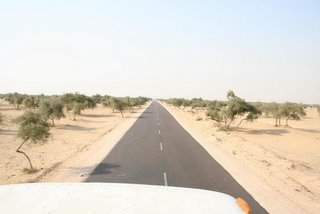
Typical roadscape of Rajasthan as taken from the much more comfortable rooftop "seats".
After being told to get off the bus at 3:00am in the morning, literally in the middle of nowhere, we somehow miraculously caught the connecting bus to arrive in Bikaner but by that time I had once again ceased to exert any semblance of control over my gastrointestinal movements, primary suspect being a very dodgy roadhouse mid-journey. My bowel was once again functioning more as a second bladder, only its discharge was somehow even more viscous. Now the three of you who actually read my previous blogs would know that I had experienced some fairly decent bouts of travellers diaorhhea in recent times but this one was mind-blowing in its severity. Seven days without so much as a hint of any solidity, literally pissing out your backside really starts to colour your experiences of a place. From here on in I'm not sure what the opposite of rose-coloured glasses are, but I was definitely wearing them. Shit brown glasses perhaps.

Suspect number 2 - Free meals and accommodation is provided for the needy (i.e. me) at the Golden Temple. I have my suspicions about the food...
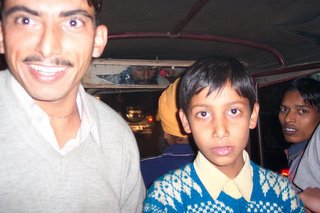
Suspect number 3 - This crazy dude we shared a taxi with stuck his finger right in my mouth. Don't ask.
Highest on crappy brown scale was undoubtedly Bikaner, a very nondescript desert town with no great claim to fame apart from a small temple about an hour out of the town into the desert, the self-proclaimed 8th Wonder of the World that is the Rat Temple. We had actually been remotely excited upon learning of this temple, images of Indiana Jones and flaming torches flickering in dark tunnels were conjured up but the reality was that it was a small open building covered in excrement with the most decrepid mangled and sickly looking rodents running all around under your feet, which were tragically shoeless (my feet, as well as the rodents) being that it is a holy temple. The whole thing took about 5 minutes to inspect and afterwards your socks had to be incinerated less you transport about 47 infectious diseases back to your hotel room.

Rat temple - Charming. Bikaner did at least have an exceptionally rich Maharaja at least who built this nice little palace, now a fancy hotel.
 One thing that I found mildly disturbing about the religious practises of Hindus is their treatment of their holy sites and animals. The river Ganges and various lakes such as that in Pushkar have tremendous significance within Hinduism yet they essentially double as the only form of organised garbage disposal I came across in India, literally everything and everything is dumped into these bodies of water.
One thing that I found mildly disturbing about the religious practises of Hindus is their treatment of their holy sites and animals. The river Ganges and various lakes such as that in Pushkar have tremendous significance within Hinduism yet they essentially double as the only form of organised garbage disposal I came across in India, literally everything and everything is dumped into these bodies of water.
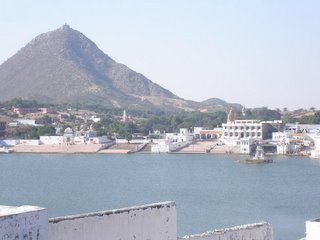
The beatiful teardrop lake/watery landfill of Pushkar.
Furthermore everybody knows of how sacred cows are to Hindus, and they literally rule the streets, I once had to wait 10minutes for a cow to move away from the door to my hotel before I could enter (they also provide the only give way traffic rule that is even remotely adhered to on Indian roads). As far as I could see however, nobody tends to look after these poor animals and so they wander about, gaunt and starving, sifting through piles of waste and garbage, eating plastic bags in desperation. In addition, there are thousands of stray dogs and wild pigs running riot everywhere, all fending for themselves in the middle of every town we came across.
For the next week of our tour as we continued our loop back towards Delhi, I continued having a crap time due to my seriously poor state of health. As a result I regrettably have few precious memories of much of the rest of the trip apart from nautiously staring up at the ceiling of our various hotel rooms and watching very strange Indian TV. There are about two actors employed in all of India as far as I can tell, Shah Rukh Khan and a one Amitabh Bachchan, a 63 year old man whose stomach complaint and following treatment made front page headlines for several weeks. He also happens to be host of Millionaire and advertise (I'm not exaggerating) in excess of 40 products. The man has more presence than Big Brother, he's literally everywhere (coincidentally his nickname is Big B, no joke).
One of the more memorable adverts we saw. Perhaps domestic violence has been in decline of recent times...

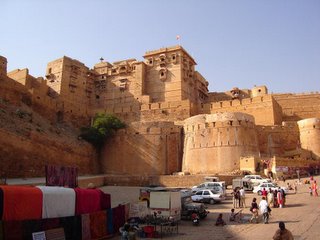
Inside the walls of the living fort of Jaisalmer (above).

The incredible blue city of Jodpur.
When I did manage to summon enough strength to venture outside, there were some fascinating highlights. Jaisalmer's living fort and surrounding village camoflauged itself within the desert surroundings that stretched on forever, the amazing blue city of Jodphur and its amazing fortress and walls that dominated the skyline and the view over the teardrop lake of Pushkar at sunset from high above, were all memorable highlights that shone out despite my inability to fully appreciate them at the time.
 Jaisalmer fort walls (above) and the markets inside (below).
Jaisalmer fort walls (above) and the markets inside (below).


The magnificent and imposing fort above Jodpur.
Of course everything in India tends to fade in comparison to the Taj Mahal. Pretty expensive to get in (750R for tourists, 20R for Indians...) but worth every penny, or paise, in my opinion. To see the immaculate detail and craftsmanship up close was something that no photo could ever convey, despite the hundreds that everyone has seen of this amazing work of art. Even some 400 years later, I´m sure that it remains as beautiful and in as immaculate condition as the day it was completed. This was common to most mughal buildings that we came across; in my opinion these forts, palaces and towers far exceeded any of their European contemporaries in majesty and opulence.
No description required.
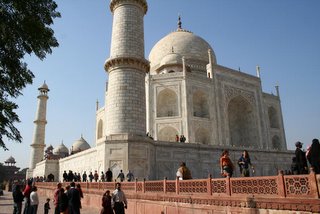
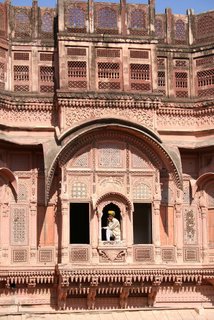
This facade carved from sandstone within the Jodpur fort is just one of the many examples of the incredible detail in so many Indian buildings.
The other great Indian work of art that rivaled the Taj Mahal itself, was of course the magnificent McDonalds Maharaja burger, the Indian Big Mac only with chicken for obvious reasons. One of my happiest memories of my time in India was the discovery in Jaipur of those beautiful golden arches after over a week of being scared shitless (very ironic in my case) to touch any Indian food. Very uncouth and culturally backwards of course and I do regret not being brave enough to experiment more with the undoubtedly delicious range of Indian cuisine but the Maharaja was just that damn good.

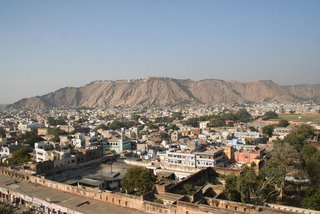
Jaipur, capital of Rajasthan and the province's only McDonalds outlet.
Once I started to regain some strength and control over my bodily functions, the things that had started to irritate me beyond sanity actually started to endear themselves to me. In a way its a shame that my two companions decided to cut short our Rajasthan tour in favour of Goa as I was only just starting to enjoy myself. I´m going to miss the haggling EVERY single time you wish to buy anything, playing the game to get the best deal, those madcap drivers of the deathtrap autorickshaws, talking endlessly about Indian cricket with anyone and everyone within two sentences of beginning a conversation, dodging cows, stray dogs and the aforementioned drivers on manic streets, the beautiful sunsets every evening (pollution does have some benefit by giving the sun a beautiful pink haze), having marching bands randomly organising a rehearsal right outside our door, catching trains through everchanging landscapes, and generally being in a land of such fascinating history where there was always something new to discover everyday. Buses not so much.
One of the many beautiful sunsets we enjoyed. All thanks to pollution....


Quite the wakeup call...
It was thus that I headed to Goa with more than a hint of remorse, even a tad of resentment, at lost opportunities in Rajasthan. The discovery of the pristine beaches, palm trees, bamboo huts, gorgeous women, delicious seafood, motor scooters and ridiculously cheap beer was enough however to convince me quite wholeheartedly of the merits of our decision. Mmm, Goa. Awesome....but more of that later,
Til then....

In memory of our good friend Buck
23.11.2005 - 25.11.2005





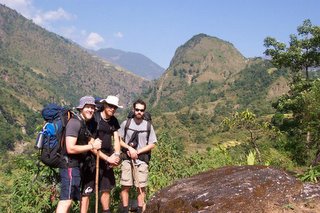


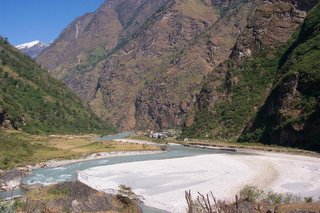
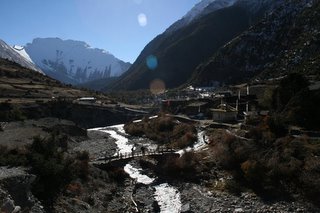 More scenes on the way up.
More scenes on the way up.


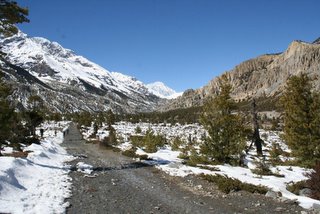 A rare patch of semi dry trail.
A rare patch of semi dry trail. 

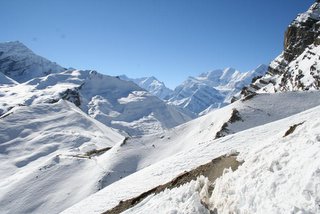
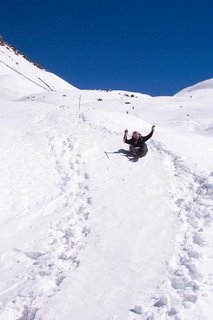
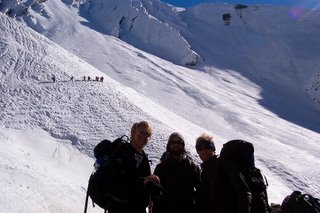

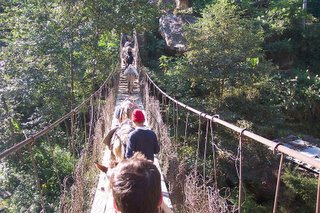
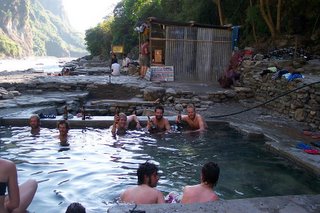


 Where are the communists?
Where are the communists? 